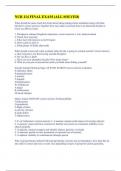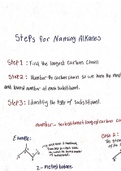PST131J
SUMMARIZED NO
2023
UPDATED QUESTIONS
ANSWERS
For inquiries and assignment help
,PST131J
Summarised NOtes
Revision Pack
Exam NOtes
, HOME LANGUAGE
STUDY UNIT 2
Pg. 13 . The Environment + Language Acquisition
A language is not learnt in isolation. Children learn from adults, their peers and in school. Babies begin to
an environment where:
1 + languages are spoken
they hear people around them speaking
people speak to them directly
the contexts in which they hear/try to speak make sense to them
Babies + young children learn to talk when:
they are highly motivated
observe/listen carefully to people around them
come to understand that language is useful and powerful
have fun and enjoy themselves as they play
practice what they learn
are rewarded
Parents/family members are great teachers because they know their baby will learn to speak. They:
help when needed, by sometimes initiating or responding to a child
extend what the child is trying to say
accept and understand that mistakes are necessary to development
do not punish their babies when they say something wrong
encourage them to keep on trying
reward/support babies’ efforts
Teachers must keep the following in mind when planning lessons:
conversation is a great vehicle for language development
children become skilled language users when they communicate with each other and with older
children/adults
a partnership/attempt to create meaning between adults and children encourages language skills and
confidence
teachers must be aware of pupils’ prior knowledge and use this in planning
teachers should share information with parents which will promote conversation between parents an
children
children should be encouraged to think out loud about their experiences
teachers learn from the mistakes children make when speaking
Language and thinking are linked. Teachers need to encourage pupils to think and communicate using lang
Language has two components: understanding + speaking
Six stages of language development:
babies react to different sounds/speech which they must hear often
vocalization (sounds) occurs from 3 months to 1 year
babies are physically capable of forming words and start to do so. They know the meaning before th
voice the words
children begin to make sentences of 2/3 words and imitate the speech patterns of those they hear
children expand vocabulary rapidly, using longer sentences, speaking to others and learning gramm
through what they hear others do
by age 5/6 children learn that language also includes reading and writing and they can make their id
feelings known by making marks on paper
Children first acquire language before they start using expressive language. Listen speak write
Communication skills
Communication means that:
children can receive a messages
children are able to interpret what they receive correctly
, children can respond adequately
teachers can improve communication skills by:
providing materials and situations conducive to communication
helping children to develop listening and speaking skills by telling stories, singing songs, playing g
Use taped stories to ask questions and discuss
Speak to children and encourage them to communicate their thoughts and feelings
Factors that indicate whether children are developing and improving:
Confidence
Articulation
Language production
Vocabulary
Communication
Understanding language
Playing with words
Listening skills
Cognitive, social and emotional development depend upon a child’s ability to understand words and comm
with them orally or written.
Elements of language
Thinking – good teachers focus on the connections between thinking and language and provide cha
and authentic learning experiences
Listening - & speaking are closely related. Media and note taking can be effective in learning
Speaking – saying what has been thought. Speaking depends on thought, vocabulary, voice and the
to produce a variety of sentences
Writing – expressing thoughts. Personal, formal, creative uses
Reading – reading begins when we learn the alphabet and how single letters together make words
Approaches to Language Teaching
Separate subjects – textbook based
Integrated language teaching – All aspects of language are studied together. Teaching of the skills a
application
Whole language – focuses on children’s own experiences. Projects such as publishing a newspaper,
reading and use of language in meaningful situations.
NCS Grade R – 9
Languages learning area includes 11 official languages as well as Braille and South African Sign Language
Additive multilingualism – all learners learn their home language and at least one additional language; lear
become competent in their additional language while their home language is maintained and developed; all
learn an African language for a min of 3 years by the end of the General Education & Training Band
Home language – learners come to school able to speak and understand the language. School supports this
competence in reading, writing, visual and critical literacies
First additional language – assumes that learners have no knowledge of this language. Introduced in Gr. 1.
by developing learner’s ability to understand and speak the language. Builds literacy on this. By the end of
these learners should be able to use their home and additional language effectively and with conference
Second additional language = those who wish to learn 3 languages. May be an additional/foreign language
time may be allocated to learning this language than the others and the purpose is to use it for general
communicative purposes
Purpose of language
Personal – relationships, personal growth + pleasure
Communicative – social contexts
Educational – thinking, reasoning and info
Aesthetic – create, interpret and play
Cultural – appreciate languages, cultures and heritage
SUMMARIZED NO
2023
UPDATED QUESTIONS
ANSWERS
For inquiries and assignment help
,PST131J
Summarised NOtes
Revision Pack
Exam NOtes
, HOME LANGUAGE
STUDY UNIT 2
Pg. 13 . The Environment + Language Acquisition
A language is not learnt in isolation. Children learn from adults, their peers and in school. Babies begin to
an environment where:
1 + languages are spoken
they hear people around them speaking
people speak to them directly
the contexts in which they hear/try to speak make sense to them
Babies + young children learn to talk when:
they are highly motivated
observe/listen carefully to people around them
come to understand that language is useful and powerful
have fun and enjoy themselves as they play
practice what they learn
are rewarded
Parents/family members are great teachers because they know their baby will learn to speak. They:
help when needed, by sometimes initiating or responding to a child
extend what the child is trying to say
accept and understand that mistakes are necessary to development
do not punish their babies when they say something wrong
encourage them to keep on trying
reward/support babies’ efforts
Teachers must keep the following in mind when planning lessons:
conversation is a great vehicle for language development
children become skilled language users when they communicate with each other and with older
children/adults
a partnership/attempt to create meaning between adults and children encourages language skills and
confidence
teachers must be aware of pupils’ prior knowledge and use this in planning
teachers should share information with parents which will promote conversation between parents an
children
children should be encouraged to think out loud about their experiences
teachers learn from the mistakes children make when speaking
Language and thinking are linked. Teachers need to encourage pupils to think and communicate using lang
Language has two components: understanding + speaking
Six stages of language development:
babies react to different sounds/speech which they must hear often
vocalization (sounds) occurs from 3 months to 1 year
babies are physically capable of forming words and start to do so. They know the meaning before th
voice the words
children begin to make sentences of 2/3 words and imitate the speech patterns of those they hear
children expand vocabulary rapidly, using longer sentences, speaking to others and learning gramm
through what they hear others do
by age 5/6 children learn that language also includes reading and writing and they can make their id
feelings known by making marks on paper
Children first acquire language before they start using expressive language. Listen speak write
Communication skills
Communication means that:
children can receive a messages
children are able to interpret what they receive correctly
, children can respond adequately
teachers can improve communication skills by:
providing materials and situations conducive to communication
helping children to develop listening and speaking skills by telling stories, singing songs, playing g
Use taped stories to ask questions and discuss
Speak to children and encourage them to communicate their thoughts and feelings
Factors that indicate whether children are developing and improving:
Confidence
Articulation
Language production
Vocabulary
Communication
Understanding language
Playing with words
Listening skills
Cognitive, social and emotional development depend upon a child’s ability to understand words and comm
with them orally or written.
Elements of language
Thinking – good teachers focus on the connections between thinking and language and provide cha
and authentic learning experiences
Listening - & speaking are closely related. Media and note taking can be effective in learning
Speaking – saying what has been thought. Speaking depends on thought, vocabulary, voice and the
to produce a variety of sentences
Writing – expressing thoughts. Personal, formal, creative uses
Reading – reading begins when we learn the alphabet and how single letters together make words
Approaches to Language Teaching
Separate subjects – textbook based
Integrated language teaching – All aspects of language are studied together. Teaching of the skills a
application
Whole language – focuses on children’s own experiences. Projects such as publishing a newspaper,
reading and use of language in meaningful situations.
NCS Grade R – 9
Languages learning area includes 11 official languages as well as Braille and South African Sign Language
Additive multilingualism – all learners learn their home language and at least one additional language; lear
become competent in their additional language while their home language is maintained and developed; all
learn an African language for a min of 3 years by the end of the General Education & Training Band
Home language – learners come to school able to speak and understand the language. School supports this
competence in reading, writing, visual and critical literacies
First additional language – assumes that learners have no knowledge of this language. Introduced in Gr. 1.
by developing learner’s ability to understand and speak the language. Builds literacy on this. By the end of
these learners should be able to use their home and additional language effectively and with conference
Second additional language = those who wish to learn 3 languages. May be an additional/foreign language
time may be allocated to learning this language than the others and the purpose is to use it for general
communicative purposes
Purpose of language
Personal – relationships, personal growth + pleasure
Communicative – social contexts
Educational – thinking, reasoning and info
Aesthetic – create, interpret and play
Cultural – appreciate languages, cultures and heritage




